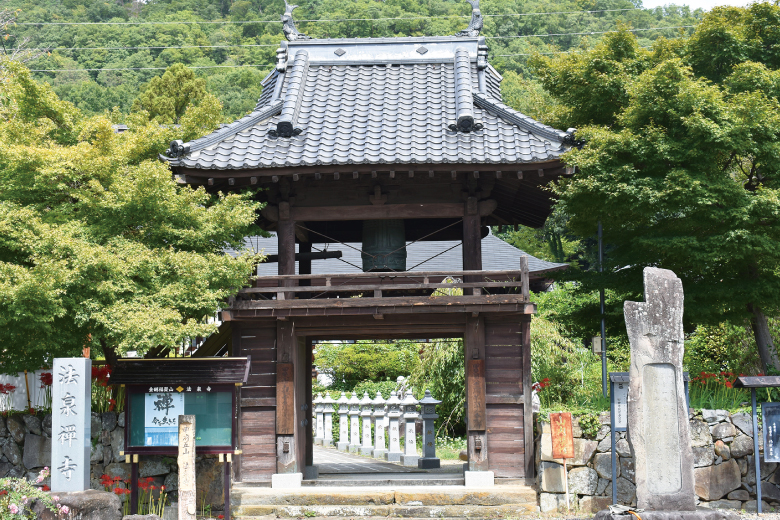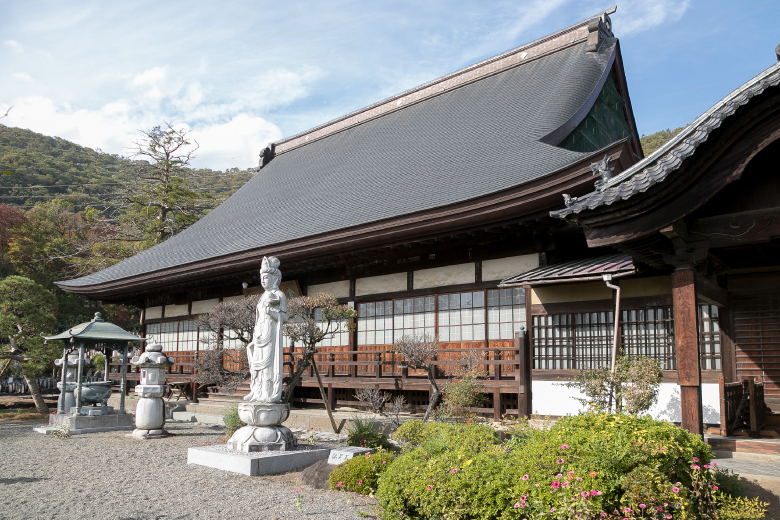Hosen-ji Temple is one of the Kofu Gozan (Five Temples of Kofu) designated for protection by Takeda Shingen. It was built in 1330 during the Kamakura Period (1185–1333) by Takeda Nobutake, seventh head of the Takeda Clan nine generations prior to Shingen who was said to have rejuvenated the Takeda Clan. The high priest Muso Soseki (Kokushi) became the temple’s founding priest. The garden at Hosen-ji is one of many gardens in Yamanashi Prefecture designed by Muso Soseki, along with the garden at Erin-ji Temple, which is nationally designated a Special Place of Scenic Beauty.
The temple is home to the graves of Takeda Shingen and Shingen’s fourth son and last head of the Takeda Clan, Takeda Katsuyori.
The Takeda Clan perished when Katsuyori committed suicide in 1582 upon suffering defeat in the Battle of Tenmokusan (Mount Tenmoku) in 1582. Katsuyori’s severed head was put on public display in Kyoto by Oda Nobunaga, but a burial rite was thereafter held for him at Myoshin-ji Temple in Kyoto.
A priest from Hosen-ji who attended the burial rite received relics of Katsuyori’s tooth and hair and buried them in the precincts of Hosen-ji with great care. The cherry tree that was planted to mark the tooth and hair burial mound still stands next to Katsuyori’s grave today.
The temple is home to the graves of Takeda Shingen and Shingen’s fourth son and last head of the Takeda Clan, Takeda Katsuyori.
The Takeda Clan perished when Katsuyori committed suicide in 1582 upon suffering defeat in the Battle of Tenmokusan (Mount Tenmoku) in 1582. Katsuyori’s severed head was put on public display in Kyoto by Oda Nobunaga, but a burial rite was thereafter held for him at Myoshin-ji Temple in Kyoto.
A priest from Hosen-ji who attended the burial rite received relics of Katsuyori’s tooth and hair and buried them in the precincts of Hosen-ji with great care. The cherry tree that was planted to mark the tooth and hair burial mound still stands next to Katsuyori’s grave today.
COURSE MAP
Where to next?
A junction: Hagiwara to the right and Yahata to the left
From Isawa to Kasugai – Heading to the town named after a road
At a three-way intersection (present-day Yanagibashi Intersection) at Betsuden in Fuefuki City, a stone tower of all souls in the three realms of existence (San-kai-ban-rei-to) remains. “The right road leads to Hagiwara, and the left road leads to Yahata” is engraved on the tower. Hagiwara Road (Hagiwara-michi) is another name for Ome-kaido Road, which passes Hagiwara on the way to Daibosatsu Pass, and Yahata Road (Yahata-michi) is another name for Chichibu Okan Road, which passes the former Yahata Village, showing that this is the junction of the Chichibu Okan Main Road (parallel to Ome-kaido Road) and the side road.
According to the “Kai-Koku-Shi” (Records of the Kai Region) edited at the end of the Edo Period, Betsuden (separate paddy) was named because there was a junction. Around Betsuden, initially the name of the road, many signposts and travelers’ guardian deity statues remain. Temples along the roads at the foot of the mountain and key points for transportation in old days are interesting spots to visit. Peach blossoms in the area provide a wonderful landscape in spring. Along the way, Iwashita Onsen has hot springs for day trippers, and a foot bath is also available at the Isawa-Onsen Station located at the end of this road.
According to the “Kai-Koku-Shi” (Records of the Kai Region) edited at the end of the Edo Period, Betsuden (separate paddy) was named because there was a junction. Around Betsuden, initially the name of the road, many signposts and travelers’ guardian deity statues remain. Temples along the roads at the foot of the mountain and key points for transportation in old days are interesting spots to visit. Peach blossoms in the area provide a wonderful landscape in spring. Along the way, Iwashita Onsen has hot springs for day trippers, and a foot bath is also available at the Isawa-Onsen Station located at the end of this road.
11.5 km(Bicycle Course)
8.3 km(Walking Course) / about 6.0 hours by bicycle /
about 7.0 hours on foot / Bicycle or Walk

